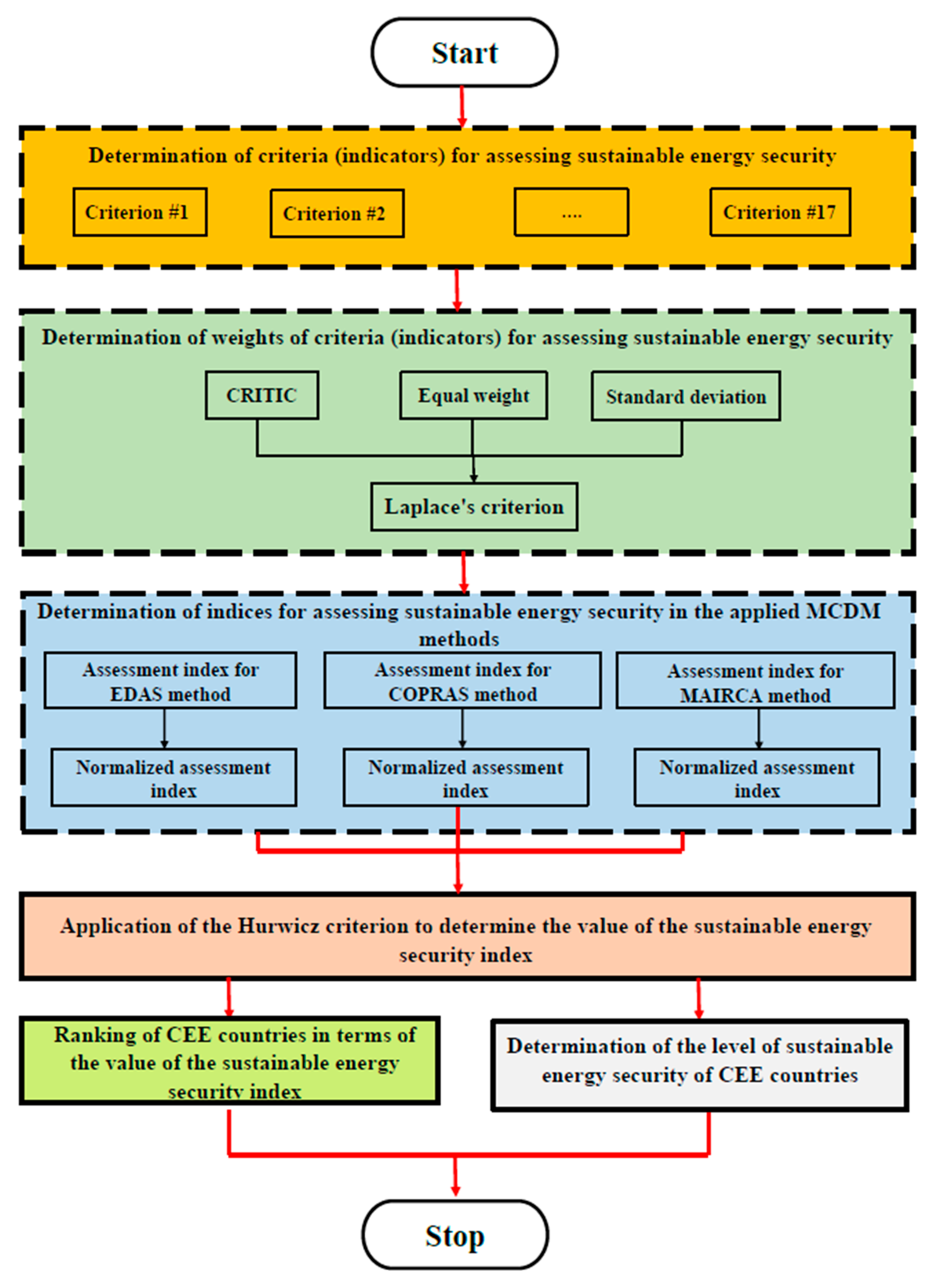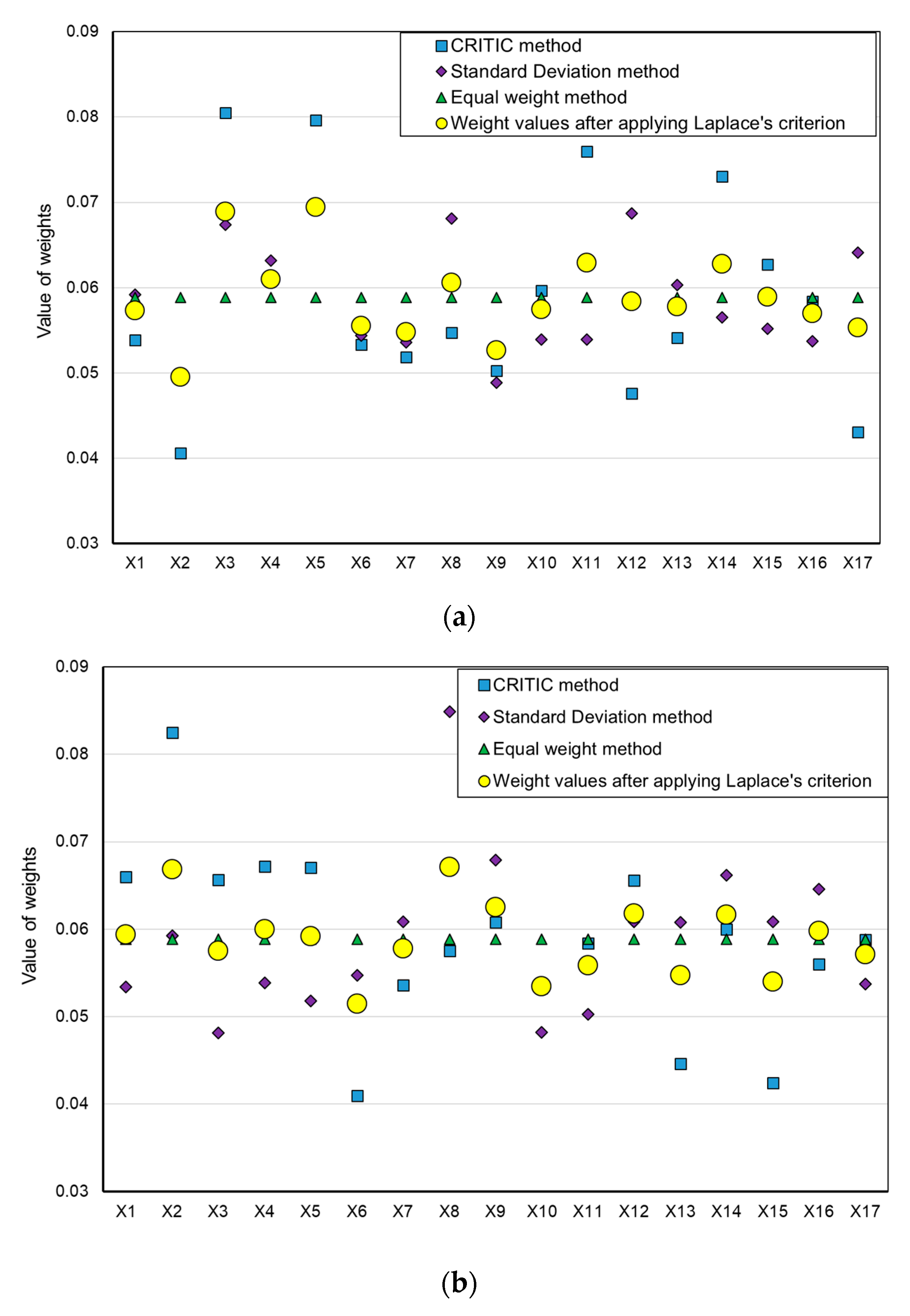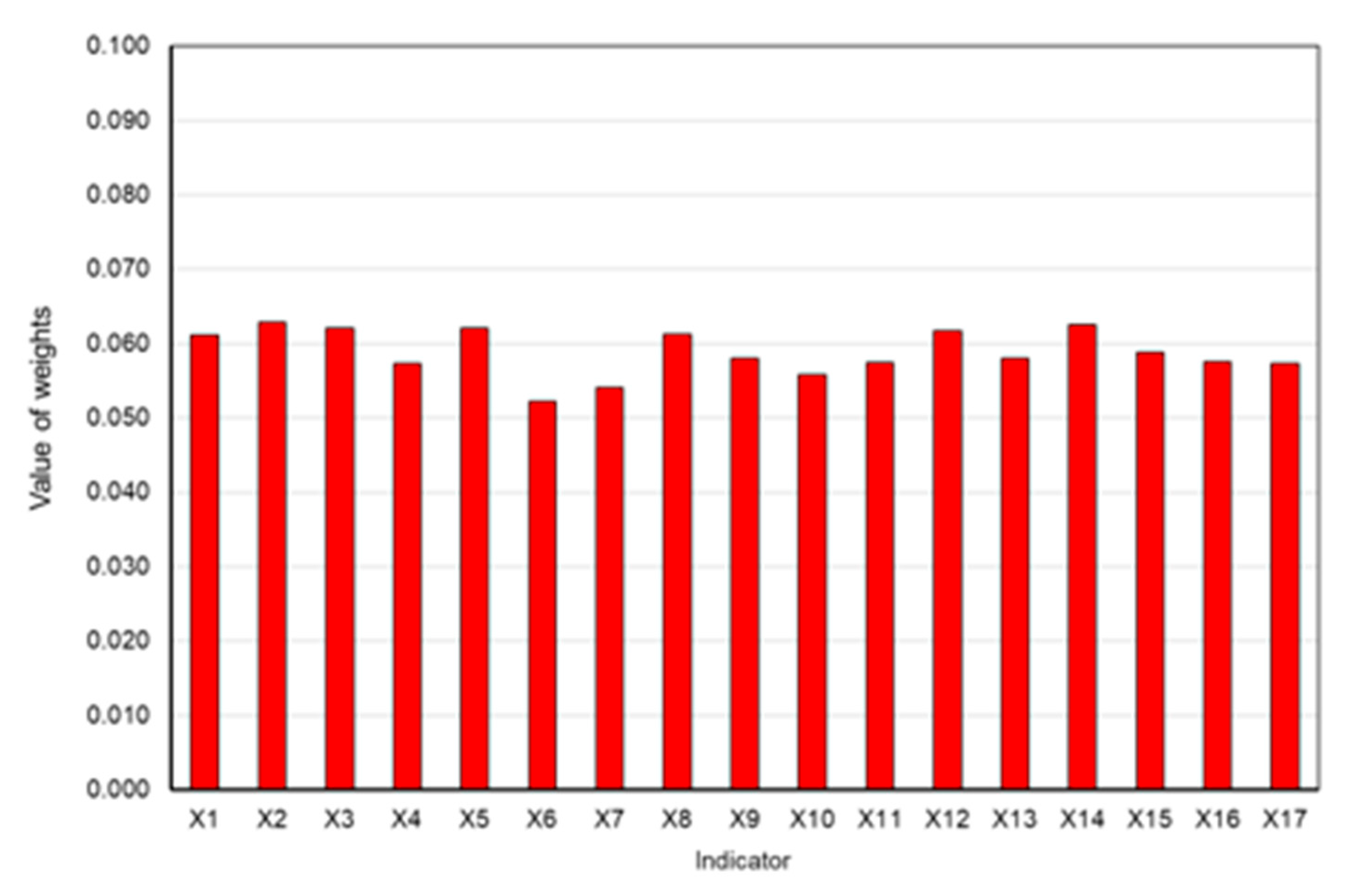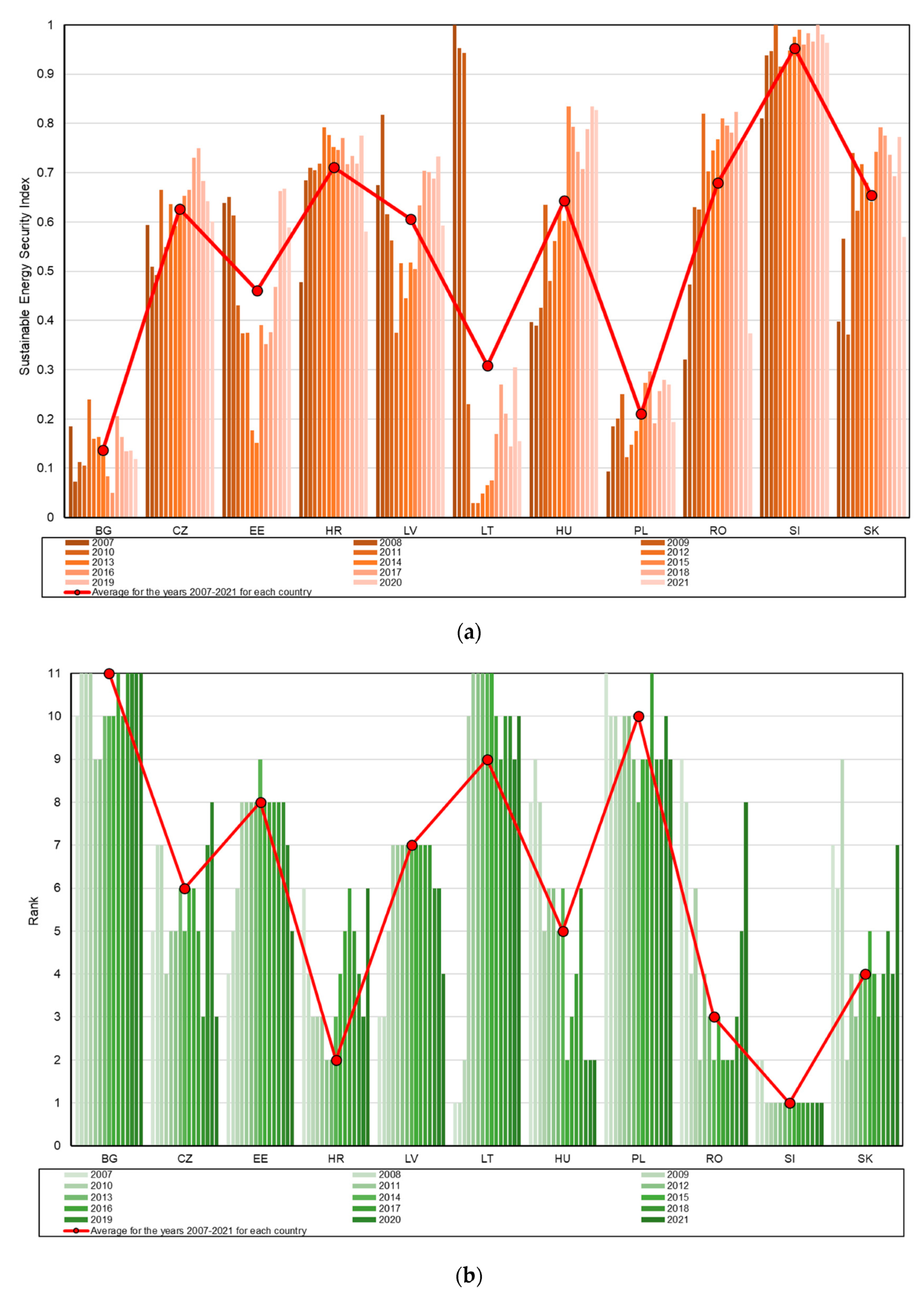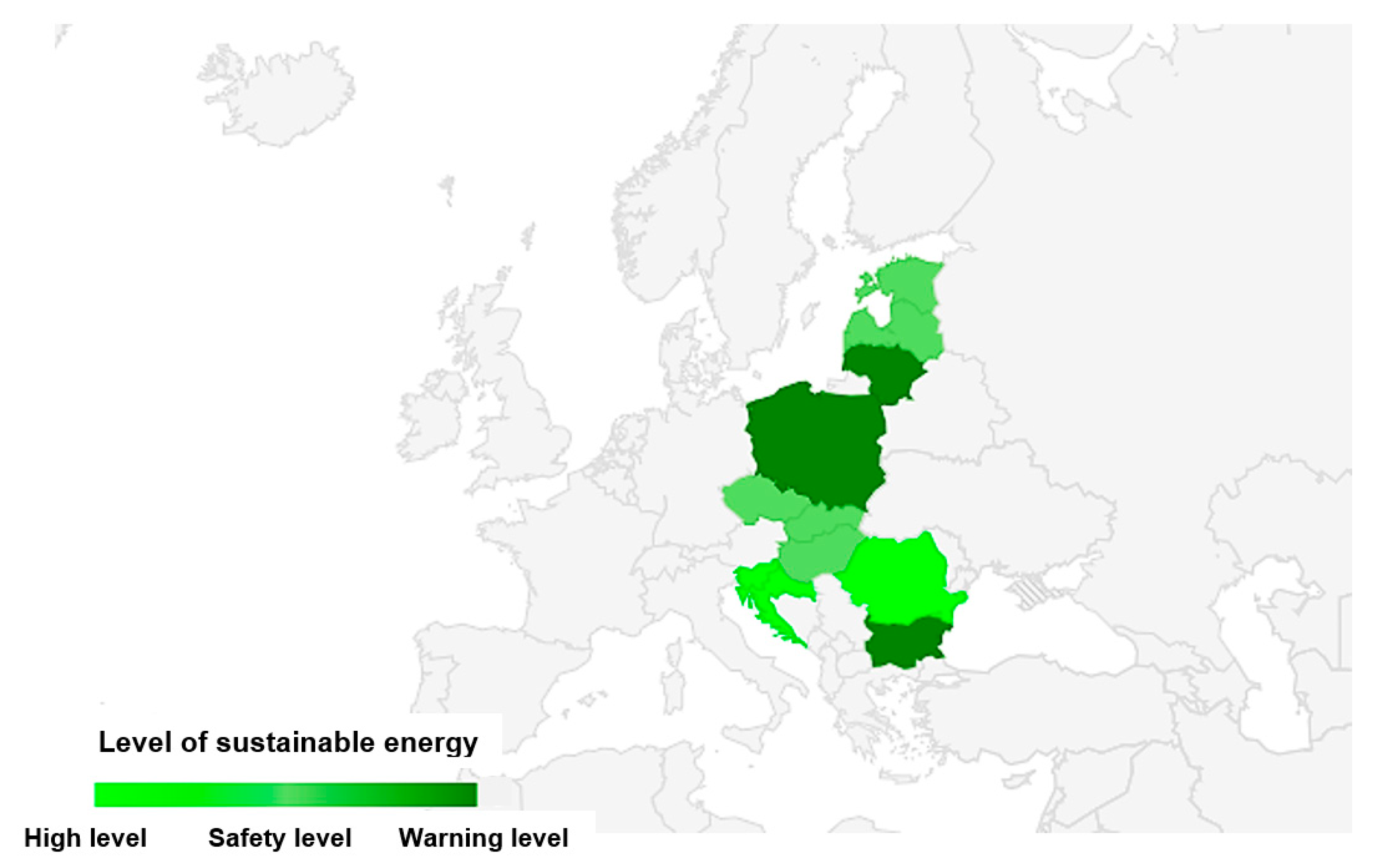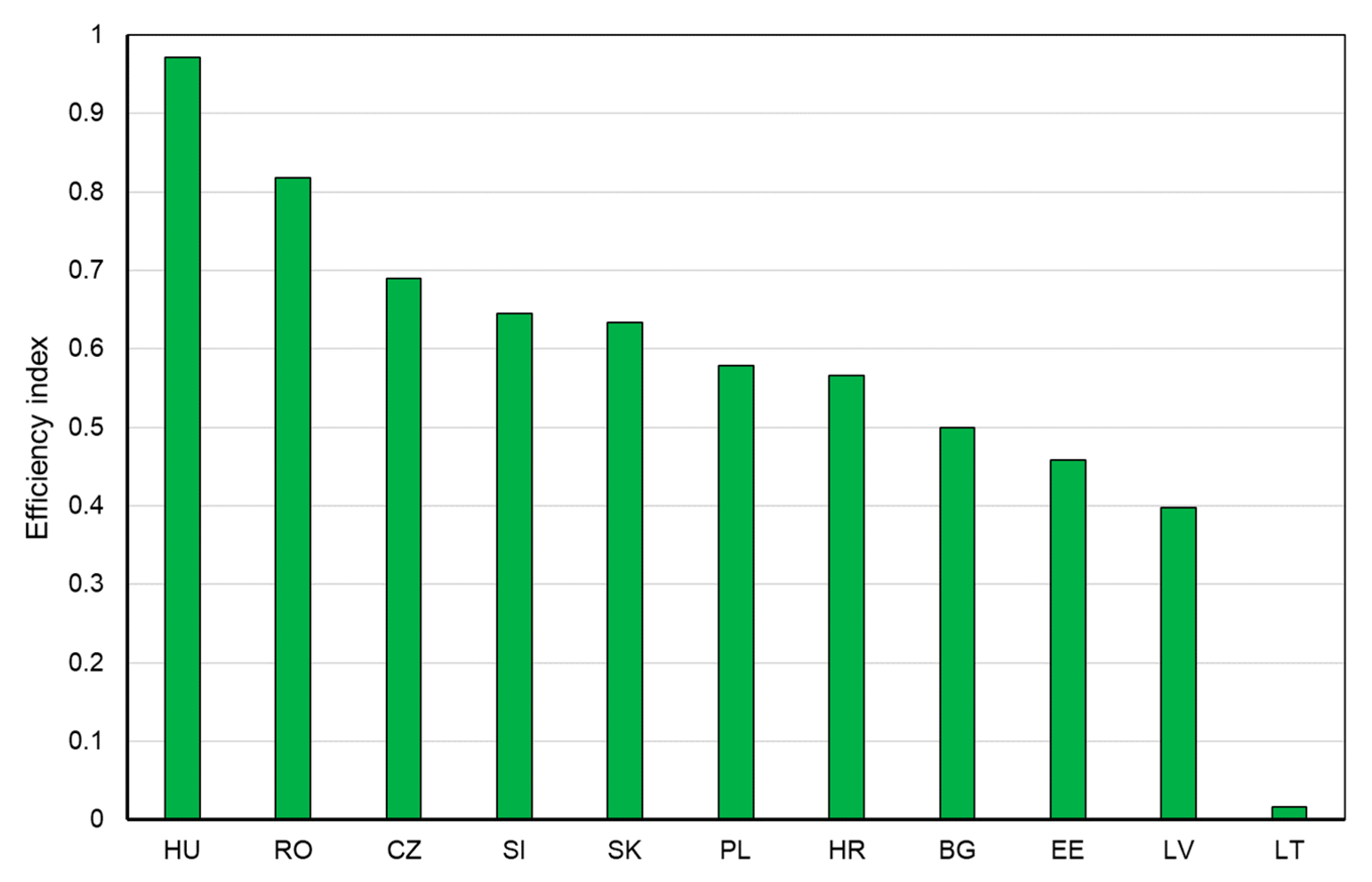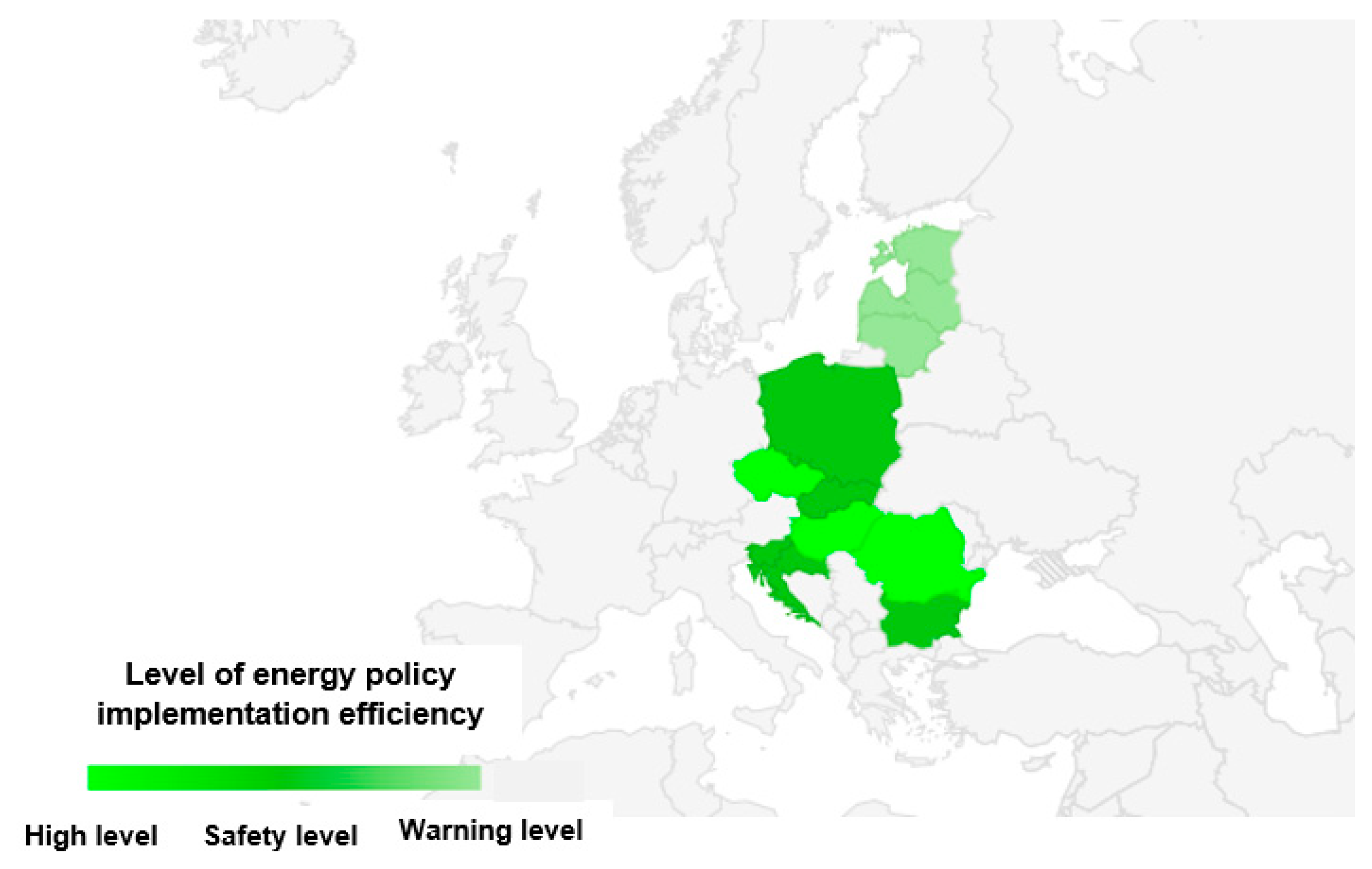1. Introduction
Access to sufficient energy at affordable prices is essential for fostering stable economic and social development in both individual countries and regions [
1,
2]. Despite various conservation measures, the global demand for energy continues to rise, driven by the increasing populations and their subsistence needs. This upward trend is further propelled by the dynamic economic growth worldwide and the evolving needs of the populace [
3]. These developments underscore the critical importance of access to affordable energy, particularly during periodic global crises. The significant global energy crisis of the 1970s heightened awareness about the need to ensure energy security, a crucial element of both national and international security, thus becoming a vital component of global politics [
4]. Consequently, ensuring energy security has emerged as a primary objective in the economic policies of countries and regions worldwide. Furthermore, energy independence has become increasingly vital for securing political and economic freedom. The ongoing dynamic economic development, driven by innovative solutions and coupled with the growing environmental consciousness among societies, has precipitated a transformation in the energy sector towards a low-carbon, cleaner, more efficient, and safer one [
5]. These changes are driven by a combination of factors, including escalating energy demands, depletion of conventional energy resources, energy crises, and heightened awareness of global warming and climate change. In this context, implementing the concept of sustainable development pertaining to key economic aspects of the world is paramount [
6].
The evolving dynamics within the global economy, alongside the increasing prominence of sustainable practices, are shaping policy decisions for numerous countries and regions worldwide. Leading the charge in embracing modern solutions is the EU, dedicated to fostering an innovative, competitive, and climate-neutral economy. Comprising 27 member countries, the EU has long been at the forefront of implementing regulations aimed at reducing reliance on fossil fuels in favor of renewable energy sources, mitigating greenhouse gas emissions, and enhancing energy efficiency [
7,
8,
9]. These measures are geared towards modernizing the energy sector on the principles of sustainable development, ultimately enhancing the quality of life for present and future generations. Despite these hurdles, the EU remains steadfast in its commitment to achieving carbon neutrality. Key policy initiatives such as the European Green Deal and Fit for 55 [
10,
11] underscore this dedication, aiming to attain climate neutrality by 2050. Implementing the objectives outlined in these initiatives requires substantial investments and often entails unpopular changes, especially in the energy sector. The adoption of these changes presents unique challenges for the 11 countries of Central and Eastern Europe (CEE), which have traditionally relied heavily on conventional energy sources. They include the following: Bulgaria, the Czech Republic, Estonia, Latvia, Lithuania, Croatia, Hungary, Slovenia, Slovakia, Poland, and Romania. Their integration into the EU has brought about significant economic, social, and political transformations. Despite experiencing substantial economic growth, the CEE region still lags behind the “old EU-14” countries in terms of income and social wealth.
Economic issues also mean that CEE countries have limited opportunities to finance investments related to environmental protection and renewable energy development. For this reason, conservative circles promote the view that the transition is a threat that could undermine the region’s competitiveness and national energy security. Hence, it can be inferred that shifts in climate policy, heightened public consciousness regarding environmental preservation, the armed conflict in Ukraine, and other disruptions in the global energy market are prompting swift alterations in EU energy policy. Given this scenario, it is entirely justified to delve into the assessment of Central and Eastern European countries regarding sustainable energy security and the effectiveness of energy policy implementation. Examining these issues over a 15-year timeframe offers ample opportunities to track and appraise changes in this regard, while also facilitating an assessment of the integration process of this group of countries with the “old EU-14”.
Considering the significance and urgency of the presented problem, the research objectives were established, aiming to determine and evaluate the level of energy security in CEE countries from 2007 to 2021, along with assessing the effectiveness of energy policy implementation during this period. The adopted concept of “effectiveness of energy policy implementation” refers to a country’s ability to achieve measurable progress in key aspects of sustainable energy security within a specified timeframe. The effectiveness of this process is evaluated using indicators of change dynamics, which quantitatively represent progress in various areas (defined by partial indicators) in relation to their initial state.
To accomplish these objectives, the author devised a research methodology and formulated the following research questions:
- RQ1.
What was the extent of sustainable energy security in Central and Eastern European countries during the period under review?
- RQ2.
How effective was the implementation of EU energy policy in the CEE countries during the period under review?
In relation to the above research questions, the following hypotheses were proposed:
H1: The level of sustainable energy security in the CEE countries during the period under review may show significant differences depending on the level of energy infrastructure development, national policies, and access to renewable energy sources.
H2: The implementation of the European Union’s energy policy in the CEE countries contributed to the improvement of sustainable energy security, particularly in terms of increasing energy source diversification and enhancing energy efficiency. However, its effectiveness varied across different countries.
To address these questions and hypotheses and accomplish the specified objectives, a methodological approach was devised, centered on identifying key indicators of sustainable energy security and utilizing Multi-Criteria Decision-Making (MCDM) methods and criteria for decision-making in uncertain scenarios. This approach also aimed to ensure a comprehensive and reliable assessment of energy security by incorporating its four key dimensions: energy, economic, environmental, and social.
The long-term perspective of evaluating sustainable energy security and the efficacy of energy policy implementation in CEE necessitates a comprehensive approach that considers various dimensions and aspects of this issue. Given its multidimensionality and complexity, this study employed multi-criteria decision support methods. The research relied on a set of 17 indicators that characterize sustainable energy security and enable the assessment of the effectiveness of energy policy implementation in CEE countries. An integral aspect of the research involved determining the weights of these indicators. To accomplish this, three objective methods (CRITIC, equal weights, and standard deviation) along with Laplace’s criterion were utilized. The cornerstone for evaluating the issue under study (sustainable energy security of the studied countries) was the Sustainable Energy Security Index (SESI), which was established based on the outcomes derived from the Complex Proportional Assessment (COPRAS), Evaluation Based on Distance from Average Solution (EDAS), and Multi-Attributive Ideal-Real Comparative Analysis (MAIRCA) methods, as well as the Hurwicz criterion.
The novelty of the discussions and research presented in this study is evidenced by several key contributions. It addresses a significant research gap by evaluating sustainable energy security and the effectiveness of energy policy implementation on a regional scale, with a specific focus on Central and Eastern European countries. This study introduces the Sustainable Energy Security Index and evaluates energy security alongside policy effectiveness for 11 CEE countries over a 15-year period, providing a comprehensive perspective on policy impacts over time. Furthermore, it develops a robust and universal methodology for assessing sustainable energy security and policy effectiveness, employing Multi-Criteria Decision-Making and the Hurwicz criterion methods. The research incorporates indicators spanning energy, economic, environmental, and social dimensions, ensuring a holistic assessment, and places emphasis on the energy mix of each country, distinguishing between conventional and zero-carbon sources—an essential consideration in the context of initiatives like the European Green Deal. Ultimately, this study expands the body of knowledge on sustainable energy security and energy policy implementation, particularly in developing countries, while also offering practical recommendations to inform future EU energy strategies and policies. In summary, the chosen subject matter, objectives, and research questions address a significant and timely issue. From both a scientific and practical standpoint, it is justified to explore this topic further.
4. Results
4.1. Assessing Sustainable Energy Security
In the initial phase of this study, computations were conducted to ascertain the weights of indicators, serving as criteria for evaluating sustainable energy security. These weights were derived using the CRITIC, Equal weight, and standard deviation methods and were based on Laplace’s criterion, as outlined in the methodology (
Section 3). The values of these weights were determined separately for each year under examination. Exemplary calculation outcomes for 2007 and 2021 are outlined in
Figure 2.
The final values of the indicator weights determined for all the years studied are shown in
Table 2.
The computed values of the indicator weights (
Table 1) exhibit minimal variability. None of the years studied show a coefficient of variation exceeding 10%. Hence, for the ultimate computations, the average values over the entire study period were utilized (
Figure 3). This methodology, characterized by a low coefficient of variation, mitigates the impact of varying indicator weight values across different years on the final calculation results.
The findings reveal that the indicators final energy consumption per capita (X2), energy imports dependency (X3), and energy sufficiency (X5) from the energy indicators group garnered the highest weights successively. Conversely, the share of non-renewables in energy mix (X6), also belonging to the energy indicators group, obtained the lowest weight values.
Table 3 provides a summary of the indicator weights for the dimensions analyzed in this study, concerning the assessment of sustainable energy security across the studied CEE countries’ population.
Based on the calculations, it can be concluded that energy and economic indicators are the most important dimensions of the assessment. The environmental dimension is the third most important for assessing sustainable energy security, and the social dimension of the assessment took the last place.
In the subsequent phase of this study, the Sustainable Energy Security Indexes (SESIs) of the CEE countries were computed for the period between 2007–2021. This computation involved employing the indices designated for this study and the corresponding weight values. The calculations adhered to the methodology outlined in
Section 3, employing a multi-hybrid approach based on the COPRAS, EDAS, and MAIRCA methods, alongside the Hurwicz criterion. Within each of these methods, method-specific indices were derived. Following a normalization process and application of the Hurwicz criterion, the final SESI values were determined for each country.
Table 4 delineates the outcomes of the sub-indices calculation, their normalization (for each method employed), and the resultant SESI values for 2021 across the CEE countries under study, alongside their respective rankings. Additionally,
Figure 4 presents the results of the sub-indices and normalized indices calculation, along with the SESI values for the CEE countries from 2007 to 2021, accompanied by their rankings.
The findings displayed in
Table 4 reveal notable disparities in the ranking positions of individual countries, contingent upon the survey method utilized to calculate the method-specific index values. Romania stands as the sole country retaining the same ranking position for 2021 across all methods employed. Conversely, slight discrepancies of one ranking position were observed for countries like Bulgaria, Lithuania, Hungary, and Slovakia. Notably, Croatia exhibited a variance of four positions, ranking seventh according to the EDAS method and third according to the MAIRCA method. Hence, to ascertain the final ranking positions based on the index values, employing the Hurwicz criterion with an optimism coefficient set at α = 0.5 was deemed a prudent approach. The normalization of method-specific indices was conducted initially, followed by their utilization to determine the Sustainable Energy Security Index values using the Hurwicz criterion. The outcomes of these calculations are shown in
Figure 4.
A comprehensive analysis of the Sustainable Energy Security Index (SESI) values for CEE countries from 2007 to 2021 reveals significant variability. Lithuania secured the highest values in 2007 and 2008, with Slovenia dominating from 2009 to 2021. Lithuania, transitioning from a leading position in 2007 and 2008 to a vice-leading position in 2009, eventually landed in ninth place by 2021. A stark decline in energy security ensued between 2009 and 2010, marked by a SESI index plunge from 0.943 to 0.229, consequently plummeting from second to tenth place. This deterioration stemmed from the closure of Lithuania’s Ignalina nuclear power plant, a critical component of its energy infrastructure. The closure, stipulated in Lithuania’s EU accession treaty, resulted in diminished energy self-sufficiency and heightened dependence on energy imports.
In contrast, Slovenia emerges as the most economically advanced among the CEE countries, boasting an energy self-sufficiency exceeding 50%. The country’s energy landscape leans heavily on renewable and nuclear sources, both zero-emission in terms of greenhouse gas emissions, which significantly bolsters energy security. Consequently, Slovenia exhibits relatively low per capita greenhouse gas emissions within the assessed group of countries, alongside a diminished reliance on imported energy sources. Notably, Slovenia’s energy mix demonstrates remarkable diversity, as evidenced by its low concentration index value of 0.23, second only to Slovakia’s 0.22 throughout the study period.
Conversely, Bulgaria and Poland consistently rank among the lowest in terms of the Sustainable Energy Security Index (SESI), failing to surpass a value of 0.3. Bulgaria faces several challenges contributing to its persistently low rating. Primarily, the country grapples with the lowest per capita GDP values among the assessed nations, severely constraining the pace of energy transition. Despite efforts to integrate renewable energy, Bulgaria’s environmental impact, measured by per capita greenhouse gas emissions, has marginally declined from 9.1 tons of carbon dioxide equivalent in 2007 to 7.9 in 2021. Nevertheless, Bulgaria continues to contend with widespread energy poverty, affecting a significant portion of its population, with an average exceeding 14% throughout the 2007–2021 period.
On the contrary, Poland’s energy landscape remains heavily reliant on conventional sources, particularly coal, owing to historical circumstances and economic legacy. Following World War II, coal emerged as virtually the sole available energy resource in Poland, shaping the country’s economy around this raw material. Despite ongoing transitions, coal continues to wield significant influence in Poland’s energy mix, contributing to the highest per capita greenhouse gas emissions and energy sector emissions among the assessed countries. As Poland gradually shifts away from domestic coal, however, its reliance on imported energy resources escalates. Over the period from 2007 to 2021, Poland’s energy self-sufficiency witnessed a notable decline, plummeting from 78% to slightly over 58%. Concurrently, the country’s energy mix diversification has improved, with the concentration of energy sources dropping from 0.4 in 2007 to 0.29. Nonetheless, Poland contends with elevated energy prices, while its GDP per capita positions the nation at the bottom of the wealth hierarchy among CEE countries, posing obstacles to energy transition. Socially, Poland exhibits moderate performance in energy security indicators relative to the assessed group of countries, although the prevalence of energy poverty has significantly decreased from 10.5% in 2007 to 5.7% in 2021. Overall, Slovenia emerges as the standout performer in terms of sustainable energy security among Central and Eastern European countries throughout the analyzed period, alongside Croatia, Latvia, Romania, and Hungary. Croatia and Slovakia maintained their positions consistently, while Belgium, Estonia, and Latvia experienced marginal declines, and Romania and Slovenia saw slight advancements. Notably, Lithuania witnessed a notable decline, dropping nine positions, whereas Hungary marked the most significant improvement (see
Table 5).
In the subsequent phase of this study, the ascertained values of the Sustainable Energy Security Index (SESI) were leveraged to evaluate the degree of sustainable energy security across the surveyed CEE countries between 2007–2021.
In the next stage of the research, the level of sustainable energy security in CEE countries for the years 2007–2021 was determined. The results of this analysis, conducted based on Equations (41)–(43), are presented in
Table 6. This table shows the classification of the studied countries according to their level of sustainable energy security, determined based on the SESI index values.
Only Slovenia consistently attained the highest level of energy security throughout all the years covered by the analysis. Comparable levels were also observed in Lithuania and Latvia during 2007–2009, Croatia during 2009–2013 and 2020, Slovakia in 2010, Romania during 2011 and 2013–2019, Hungary during 2015and 2019–2021, and the Czech Republic during 2018 and 2021.
Conversely, Poland and Bulgaria consistently operated at a warning level for sustainable energy security throughout the entire analysis period. Lithuania also maintained this warning level from 2010 to 2021, with isolated occurrences in Romania (2007), Hungary (2008), and Slovakia (2009).
These delineated levels highlight Romania, Hungary, and Slovakia as the countries that have implemented the most effective measures in ensuring sustainable energy security and have demonstrated significant improvements in this regard.
The average level of sustainable energy security across the studied countries for the entire analyzed period is depicted in
Figure 5.
Based on the obtained results, the validity of the first hypothesis can be confirmed. This analysis revealed significant variation in the levels of sustainable energy security among CEE countries. It also highlights the substantial influence of various factors on these results, such as the degree of energy infrastructure development, implementation of national policies, and the availability of renewable energy sources in individual states. Countries like Slovenia, Lithuania, and Latvia achieved higher levels of energy security, while Poland and Bulgaria consistently ranked at the warning level. This confirms the diversity in sustainable energy security levels within the region.
4.2. Assessing the Effectiveness of Energy Policy Implementation in CEE Countries from 2007 to 2021
Utilizing the determined index values of the dynamics of change of the indicators employed in this study (see
Appendix A) and following the outlined research methodology (
Section 3), an analysis was conducted to establish an index gauging the effectiveness of energy policy implementation in CEE countries over the long term (15 years), and to evaluate this efficacy. The yardstick for measuring the effectiveness of policy implementation was the index value representing the magnitude of changes in the indicators over the period spanning from 2007 to 2021 (see
Appendix A,
Table A1). The values of the efficiency index for energy policy implementation in CEE countries are shown in
Figure 6. Meanwhile,
Figure 7 illustrates the level of CEE countries in terms of energy policy implementation efficiency over a 15-year perspective.
Hungary, Romania, and the Czech Republic demonstrated the highest levels of efficiency in implementing energy policies based on the evaluation criteria outlined in this study, while Estonia, Latvia, and Lithuania exhibited the lowest levels. Slovenia, Slovakia, Poland, Hungary, and Bulgaria fell within the moderate range. This discrepancy can be attributed to the fact that countries with weaker assessment indicators at the beginning of the study in 2007 found it comparatively easier to make significant progress, such as in reducing greenhouse gas emissions and increasing the proportion of renewable energy sources in their energy mix while decreasing reliance on conventional sources.
Hungary, which attained a score of 0.971 in terms of energy policy implementation efficiency (see
Figure 6), stands out among the assessed countries due to notable increases in total energy supply per capita and enhanced energy self-sufficiency. The substantial impact on this favorable outcome can be attributed to lower energy prices in 2021 compared to 2007 [
63]. Hungary experienced a 23% reduction in prices for household consumers, a feat unmatched by any other surveyed country (see
Appendix A,
Table A1), and a 10% reduction for non-household consumers. Hungary’s energy mix features nuclear power, setting it apart from other nations that do not utilize this energy source. Concurrently, there has been a decline in the share of non-renewable energy sources in the mix alongside an increase in renewable resources. Hungary also demonstrates positive strides in CO
2 reduction, evidenced by negative dynamics of change over the review period. Additionally, Hungary has made significant headway in reducing energy poverty among its citizens, trailing only behind Bulgaria, Poland, and Latvia in this aspect. Notably, Hungary has achieved the most substantial reduction in the index of excessive housing costs, which encompass energy expenses, outperforming all other studied countries in this regard. Hence, it can be inferred that the top-ranking positions were primarily influenced by energy prices, social indicators, and shifts in the energy mix impacting energy self-sufficiency.
Romania secured the second position (index value = 0.817). Notably, the country exhibited significant changes in its energy mix, marked by a 12% decrease in non-renewable sources alongside notable increases in renewable sources and nuclear energy—a commendable achievement, with a 68% increase over the 15-year period, marking the highest growth rate among the studied countries. Romania’s above-average GDP per capita growth also contributed to fostering an environment conducive to effective energy policy implementation and energy sector transformation. Additionally, Romania showcased positive strides in CO2 reduction, ranking fourth in this aspect. The noteworthy improvement in energy productivity, reflecting the value or services generated with a given energy consumption, is also noteworthy. Romania and Estonia experienced a remarkable 65% increase in this indicator, while Latvia exhibited the smallest growth at only 13%.
The Czech Republic clinched the third position in terms of energy policy implementation efficiency, securing a score of 0.690. The country excelled in transitioning its energy mix towards zero-carbon alternatives, notably augmenting the share of renewable and nuclear energy sources, resulting in a noteworthy 25% reduction in greenhouse gas emissions. Significant reductions in energy prices, particularly for non-household consumers—7% lower in 2021 compared to 2007—significantly contributed to the Czech Republic’s commendable performance. Furthermore, the country made considerable strides in reducing energy poverty, witnessing a 52% decrease in 2021 compared to 2007 [
63].
Following Slovenia, Slovakia received a slightly lower rating but demonstrated commendable achievements in reducing CO2 emissions and decreasing the share of non-renewable sources in its energy mix to 11% over the study period, while concurrently increasing the share of nuclear energy. Slovakia’s GDP per capita growth rate was deemed average within the surveyed group, standing at 56% over the analyzed period.
Three countries fell within the 0.5–0.6 rating range: Poland, Croatia, and Bulgaria. While Bulgaria and Poland notably augmented the share of renewables in their energy mixes, Croatia achieved this to a lesser extent. However, Croatia initially possessed a larger share of renewables at the beginning of the analysis period, resulting in a less dramatic increase over the 15-year period compared to countries with a minimal initial share in 2007. Notably, Croatia and Bulgaria effectively reduced the share of conventional sources in their energy mixes compared to Poland. Moreover, Bulgaria managed to reduce its dependence on imported energy sources, whereas Croatia and Poland witnessed an increase in this dependence, notably soaring by nearly 60% for Poland. These countries, particularly Bulgaria and Croatia, are actively pursuing policies to curtail CO2 emissions per capita, with a negative rate of change observed over the 15-year period. Notably, Bulgaria achieved the most robust results in terms of GDP per capita growth among all CEE countries.
The next group of countries, with overall scores ranging from 0.0 to 0.5, encompassed Estonia, Latvia, and Lithuania, collectively known as the Baltic States. These nations witnessed a significant increase in energy prices for both household and non-household consumers over the 15-year period. Estonia and Latvia notably boosted energy self-sufficiency, while Lithuania experienced a significant decrease, primarily due to the closure of its last nuclear power plant in 2009 and a consequent rise in energy dependency between 2007 and 2021. Consequently, there was a surge in the share of energy derived from conventional sources in Lithuania’s energy mix, nearly 1.5 times that of renewables. Conversely, Estonia achieved near-complete independence from imported energy sources during this period, with the share of renewable energy in its mix nearly tripling. Estonia and Lithuania witnessed a reduction in available energy per capita between 2007 and 2021. While Estonia also decreased final consumption, Latvia and Lithuania saw an increase in their shares. Despite these fluctuations, all three countries exhibited commendable growth rates in GDP per capita.
However, Latvia and Lithuania experienced a notable increase in CO2 emissions per capita and GHG Intensity of Energy. While Estonia and Lithuania marginally reduced the extent of energy poverty, it is noteworthy that these countries had the lowest indicators in this regard in the initial year of analysis (2007).
In summary, countries with more favorable indicator values in 2007 faced challenges in achieving spectacular percentage increases or decreases in subsequent years—a comprehensible phenomenon. Nonetheless, the results obtained facilitate comparisons and evaluations of changes over the study period.
Table 7 provides an overview of each country’s best and weakest performances in the analysis of individual indicators.
The analysis of the results presented in
Table 7 shows that Central and Eastern European (CEE) countries achieve varied outcomes for the individual indicators studied. Poland stands out with the largest increase in energy supply per capita and an improvement in the diversification of the energy mix (lowest HHI concentration index). Meanwhile, Estonia achieved the best results in reducing energy import dependency and the share of non-renewable sources in the energy mix. Bulgaria recorded the highest increase in the share of renewable energy sources in the mix and the largest growth in GDP per capita—319% and 313%, respectively, compared to the base year.
On the other hand, it can be observed that Latvia experienced a 2% increase in greenhouse gas emissions per capita compared to the base year, and Slovakia saw a 54% rise in the percentage of people at risk of energy poverty.
The results confirm the validity of the second hypothesis. They indicate the effectiveness of implementing EU energy policy in CEE countries. Despite varying results among individual states, there are evident improvements in enhancing sustainable energy security. These findings support the validity of the pursued policies and the efficiency of the measures implemented in the region.
5. Discussion
Ensuring energy security while simultaneously achieving energy policy goals are priorities in EU economic policy. The implementation of these policy objectives is mandatory for all member countries, including those located in the Central and Eastern part of Europe. Despite political and economic setbacks and the resulting economic challenges and social resistance, these countries are obligated to implement the principles of sustainable development, including, notably, the European Green Deal strategy.
The implementation of the highly ambitious goals of EU climate policy, however, entails significant costs and the necessity of transforming the economies of individual countries, particularly in the energy sector. For highly developed and wealthier countries (referred to as the “old EU-14”), these costs seem relatively smaller compared to those for the so-called “new EU-13” countries. In these countries, located in Central and Eastern Europe (CEE), the challenges associated with energy transformation, building energy independence, and overall efficiency in the energy sector are significantly greater than in other EU countries. This is primarily due to the lower wealth of these countries and social resistance to the necessary changes stemming from the considerably shorter period of building a free-market and competitive economy. This situation leads to certain social groups, especially those dependent on conventional energy resources, expressing concerns and opposition to the radical changes associated with energy transformation [
74,
75,
76]. There are also significant concerns about the costs of this process, which must be borne by the entire society [
77,
78].
On the other hand, these societies are aware that due to the increasingly deteriorating state of the natural environment, changes in energy policy are necessary. In the past two years, this awareness has grown even more due to the armed conflict in Ukraine. This event has made many countries realize the importance of energy independence and sector efficiency, which determine energy security. In this context, undertaking work involving a study of the state of energy security of CEE countries and their implementation of the EU’s common energy policy becomes fully justified.
There is no doubt that the process of ensuring sustainable energy security and effective implementation of energy policy must continue in CEE countries. The principles of EU energy and climate policy apply to all member states. An important aspect of this policy is also the strengthening of regional cooperation among all EU countries, including those in the CEE region. However, it is evident that countries in this region face many common challenges, including a significant share of non-renewable sources in their energy mixes, energy dependence, high greenhouse gas emissions, energy poverty, and high energy prices.
According to the principles of EU energy policy, zero-emission sources, primarily renewables, should become the foundation of sustainable energy security [
15,
16,
17,
18,
19]. However, as indicated in [
79], transitioning the energy sector to a zero-emission economy while maintaining energy security and implementing EU energy policy may not be an easy process for CEE countries. This is due to potential social, technical, and primarily economic challenges. As the results of [
80,
81] show, the energy transition in CEE countries, as emerging and developing economies, is proceeding at a relatively slow pace. A significant number of CEE countries also face many problems and difficulties in achieving environmental goals, such as reducing greenhouse gas emissions [
82], decreasing energy dependence, or eliminating energy poverty [
83,
84,
85]. Among other factors, these challenges led to the adoption of a multidimensional approach in the conducted research to address this crucial issue for the entire European community.
As the results of the conducted research indicate, this broad approach provided an opportunity to assess both the overall energy security of these countries and the individual dimensions included in the analysis. Over a 15-year perspective, a medium-high level of sustainable energy security, covering energy, economic, environmental, and social dimensions, was characterized by Slovakia, Romania, and Croatia, while a warning level was observed in Poland, Bulgaria, and Lithuania. It is evident that the level of designated energy security in CEE countries is diverse. The obstacles to ensuring a high level of sustainable energy security in these countries stem from the complexity of the problem and the economic, social, and political specificities of this group of countries.
The observed differences in energy security levels among Central and Eastern European (CEE) countries highlight the crucial role of political decisions and the implementation of specific strategies in shaping their energy resilience. Countries that achieved higher energy security levels, such as Slovakia, Romania, and Croatia, benefited from a combination of strategic investments and favorable policy measures. Slovakia’s focus on nuclear energy ensured a stable and relatively low-emission energy source while reducing dependence on imported fossil fuels [
86,
87]. Romania, on the other hand, developed a well-balanced energy mix by integrating hydropower, wind energy, and natural gas while maintaining a strong domestic energy production sector [
88]. Croatia leveraged its geographic location to develop LNG infrastructure, creating an alternative supply route and reducing dependence on Russian gas [
89]. In addition to diversifying energy sources, these countries actively increased the share of renewable energy by utilizing both national support programs and EU funds. Romania has become a regional leader in wind energy development [
63], while Croatia has harnessed its hydro and solar potential to strengthen sustainable energy production [
90].
A key factor that also contributed to the higher level of energy security in these countries was the implementation of energy efficiency improvement policies aimed at optimizing energy consumption across various sectors. Slovakia focused on enhancing energy efficiency in industry and residential construction [
91]. Meanwhile, Croatia modernized its energy grid and implemented smart grid technologies, improving energy management [
92].
In contrast to these countries, Poland, Bulgaria, and Lithuania face challenges that contribute to their lower level of energy security. Poland’s strong dependence on coal, while providing a certain degree of energy independence, simultaneously creates economic and environmental barriers that have hindered the transition to a more sustainable energy model [
93]. Bulgaria and Lithuania, historically reliant on imported energy resources, particularly natural gas, have remained vulnerable to geopolitical disruptions affecting their energy stability. One of the key issues in these countries has been the slow pace of renewable energy deployment. Despite efforts to develop renewable energy sources, Poland’s transition away from coal has been significantly slower than in other countries in the region [
94,
95]. Similarly, Bulgaria and Lithuania struggle with investment and regulatory barriers that hinder the expansion of renewable energy infrastructure.
Another significant factor that contributed to the lower level of energy security in these countries during the analyzed period was the delay in modernizing energy infrastructure. Additionally, these countries have faced—and continue to face—difficulties in implementing energy policies. Socioeconomic factors, such as a high degree of energy poverty and public opposition to certain energy reforms (e.g., the transition away from coal in Poland), represent major obstacles to achieving a more secure and sustainable energy system [
96].
Fundamentally, CEE countries remain heavily dependent on conventional energy sources such as coal and natural gas, which significantly hinders the development of a zero-emission economy based on renewables [
79,
97]. Despite substantial potential for renewable energy development, reliance on traditional sources continues to serve as a major barrier to energy transition, as seen in the case of Lithuania [
98,
99,
100,
101]. Another major obstacle is the inadequate infrastructure needed to support renewable energy expansion. Improving this infrastructure requires substantial investments and a coherent European Union policy, particularly regarding financing mechanisms. It is clear that CEE countries need a dedicated program and strategy to accelerate the development of alternative energy sources, ensuring long-term energy security and sustainability in the region.
An important direction for energy transformation that should enhance regional security is the development of nuclear energy, classified as a zero-emission energy source. Currently, it is only utilized in six countries: Bulgaria, Czech Republic, Hungary, Slovenia, Slovakia, and Romania. Some countries, such as Poland, plan to launch nuclear power plants to improve energy independence and increase security in this area, but their construction requires time and adequate resources. The effects of combining different energy sources are evident in Slovenia and Romania, countries with a high level of sustainable energy security. Such combination of non-renewable energy sources with renewable and nuclear energy sources results in these countries having very balanced and diversified energy mixes at the current stage of energy transformation. As highlighted by Marquesa et al. [
102], the integration of different energy sources enhances efficiency in both environmental protection and energy security. The findings of this study corroborate these conclusions.
It is also noteworthy that a high level of sustainable security within the CEE group of countries is not limited to countries with high GDP per capita values. While Slovakia and Croatia fall into this category, Romania is among the poorest CEE countries. This is particularly evident in the area of energy poverty, where the highest levels are found in Romania and Bulgaria.
The results also indicate that wealthier CEE countries developing zero-emission energy sources have lower greenhouse gas emissions than less wealthy countries with more conventional energy mixes. This confirms the findings of studies presented in the works [
103,
104]. This regularity seems logical, as building a zero-emission economy requires significant and costly investments, or incentive programs, for businesses and households to implement such solutions [
105].
It can therefore be assumed that the state of energy security in CEE countries is not satisfactory. Its improvement requires substantial investments, but above all, it requires a targeted pro-environmental policy and measures to promote the idea of a zero-emission economy in society.
All measures aimed at improving sustainable energy security require decisive action by government and local authorities, as well as social acceptance for a fair energy transition [
106,
107]. Energy transition processes in the European Union must take into account, as demonstrated in this study, the specifics of CEE countries and their diversity and problems in implementing a coherent EU energy policy.
However, it is evident, as also demonstrated by the conducted research, that CEE countries have been taking steps to promote renewable energy and systematically increase their share in energy mixes since joining the European Union. This is evident even in final consumption, where the share of energy from renewable sources is growing. Energy efficiency, supply security, reduced energy dependence, and greenhouse gas emissions are also clearly improving in these countries. This results in an overall improvement in the energy security of these countries, which aligns well with the goals of EU energy policy.
The discussion presented here represents only a fraction of the possible implications and interpretations of the results obtained. Their comprehensiveness and multidimensionality, as well as the timeliness and validity of the subject matter undertaken, provide ample opportunities for further evaluation, comparison with other studies, and inference.
6. Conclusions and Future Research Directions
Based on the developed methodology, a study was conducted to assess the sustainability of energy security from 2007 to 2021 in CEE countries and to evaluate the effectiveness of their energy policies during this period.
Assessing the sustainable energy security of these countries is crucial from both scientific and practical perspectives, considering its multidimensional nature and its significance for the development of modern economies. Energy independence serves as a cornerstone for the advancement of free-market principles and competitive economies.
In this study, an original research methodology was devised, considering the multidimensional aspects of energy security. The methodology incorporated Multi-Criteria Decision-Making (MCDM) methods and criteria for decision-making under uncertainty. By examining four dimensions related to the energy sector and utilizing 17 indicators to characterize them, a comprehensive understanding of the issue was achieved. This methodology was applied to assess the sustainability of energy security and the effectiveness of energy policies in 11 CEE countries over the period from 2007 to 2021. The research findings revealed several key insights:
- -
CEE countries exhibited spatial and temporal variation in the level of sustainable energy security during the study period.
- -
Slovenia consistently demonstrated the highest level of energy security throughout the analysis, with occasional peaks in other countries during specific years.
- -
Poland and Bulgaria consistently remained at a warning level for sustainable energy security throughout the study period, with Lithuania also experiencing this warning level from 2010 to 2021.
- -
Lithuania experienced significant deterioration in energy security due to the closure of its last nuclear power plant in 2009, leading to increased dependence on imported energy sources and a shift in the energy mix structure.
- -
Romania stood out as the top performer in terms of energy security, maintaining an average energy self-sufficiency of 77% over the entire study period.
- -
Hungary, the Czech Republic, and Romania demonstrated the most effective implementation of EU energy policies, while Latvia, Estonia, and Lithuania scored lower in this regard.
The assessment methodology developed and implemented in this study holds promise for future research endeavors, both within EU countries and on a broader international scale. Regular studies on sustainable energy security and the effectiveness of energy policies are crucial for evaluating and refining energy and economic strategies over time. The methodology presented in this paper represents a significant cognitive achievement, offering flexibility in criteria selection, the scope of countries studied, and the duration of analysis.
In the context of the conducted research and obtained results, it is also important to highlight their limitations. The analysis of sustainable energy security was based on the assessment of four main dimensions: energy, economic, environmental, and social. While this approach is multidimensional, it does not allow for detailed tracking of progress within each individual dimension. The overall SESI index value does not directly reveal significant differences and trends that occurred between 2007 and 2021 in each of these areas.
Future in-depth research should therefore include detailed analyses of the indices for each dimension, along with their dynamic changes. This would enable a more nuanced understanding of the situation in individual countries, considering their specific contexts. A better understanding of actual changes in the various dimensions within the studied countries would also allow for more detailed conclusions and the development of practical recommendations. The conducted research provides opportunities to assess the situation of a given country in comparison to the entire group of CEE countries. However, it is challenging to clearly evaluate the changes that have occurred in individual countries over the studied period within the specified dimensions. Undoubtedly, such analyses would be extensive, but they should be considered for inclusion in future studies, possibly on a smaller scale.
In this area, for selected countries, it would also be valuable to study changes in the values of individual indicators. This higher level of detail would allow for the precise identification of issues related to sustainable energy security. In the future, it would be beneficial to conduct a more detailed temporal analysis for each country individually, capturing the dynamics of its changes without reference to the results of other nations. Such an approach would enable more accurate monitoring of policy implementation effectiveness and help identify areas requiring additional action within a given country.
The developed methodology, along with the conducted research and obtained results, offer significant potential for further exploration in this field. A logical step would be to extend the analysis to encompass all EU countries, including both the “new EU-13” and “old EU-14” countries. Incorporating data from a wider range of countries would enable more comprehensive comparisons and the identification of clusters of similar nations that could collaborate effectively in establishing a European energy security framework. This becomes particularly vital given the EU’s composition of numerous relatively small countries, emphasizing the need for close cooperation on critical issues like energy security.
Additionally, it is essential to address the utilization of fossil resources while mitigating their environmental impact, especially in light of the costs associated with developing renewable energy sources and the environmental consequences of emerging technologies. Exploring avenues for enhancing energy security, particularly for countries with significant fossil fuel reserves, while minimizing environmental harm should be duly considered.
